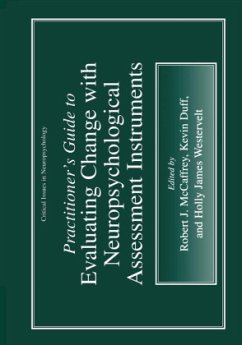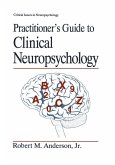Until now, clinical neuropsychologists had few guidelines to assist them in determining if a change in a patient's performance across assessments was due to an intervention, maturation, practice effects or a combination of factors.
The editors of Practitioner's Guide to Evaluating Change With Neuropsychological Assessment Instruments have done a thorough review of the literature from 1970-1998 and extracted and compiled all reported information on practice effects. Each table in this volume includes information on the subject/patient groups, the n, gender, age, intervention, interval between assessments, scores at both assessment points, and the original reference citation. The tables are listed alphabetically for the seventy-five most widely used assessment instruments.
This one-of-a-kind reference will provide clinicians, as well as researchers with an invaluable resource.
The impetus for this volume began with our research in the 1980's involving serial neuropsychological evaluation with various patient populations. At that time, reports on the practice effects associated with routinely utilized clinical neuropsychological instruments were sparse. While test-retest data were available for almost all assessment instruments, this was usually in the form of correlation coefficients and not changes in mean performance between or across assessment periods (see McCaffrey & Westervelt, 1995 for a detailed discussion of these and related issues). Clinical neuropsychological practitioners had few guidelines to assist them in determining if a change in a patient's performance across assessments was due to an intervention, maturation, practice effects, or a combination of factors. This volume represents our efforts at reviewing the literature between 1970 and 1998 and extracting the reported information on practice effects. The tables include the assessment instrument used, information on the subject/patient groups, the sample size (n}, gender, age, intervention, interval between the assessments, scores at both assessment points, and the citation. Those studies that reported data on more than two assessment points are indicated by a notation~ however, any data beyond the second assessment are not reported and the interested reader should refer to the original article. The tables are arranged alphabetically for the most widely used assessment instruments. Those instruments for which there was limited data on practice effects are grouped by "domain" (e. g.
The editors of Practitioner's Guide to Evaluating Change With Neuropsychological Assessment Instruments have done a thorough review of the literature from 1970-1998 and extracted and compiled all reported information on practice effects. Each table in this volume includes information on the subject/patient groups, the n, gender, age, intervention, interval between assessments, scores at both assessment points, and the original reference citation. The tables are listed alphabetically for the seventy-five most widely used assessment instruments.
This one-of-a-kind reference will provide clinicians, as well as researchers with an invaluable resource.
The impetus for this volume began with our research in the 1980's involving serial neuropsychological evaluation with various patient populations. At that time, reports on the practice effects associated with routinely utilized clinical neuropsychological instruments were sparse. While test-retest data were available for almost all assessment instruments, this was usually in the form of correlation coefficients and not changes in mean performance between or across assessment periods (see McCaffrey & Westervelt, 1995 for a detailed discussion of these and related issues). Clinical neuropsychological practitioners had few guidelines to assist them in determining if a change in a patient's performance across assessments was due to an intervention, maturation, practice effects, or a combination of factors. This volume represents our efforts at reviewing the literature between 1970 and 1998 and extracting the reported information on practice effects. The tables include the assessment instrument used, information on the subject/patient groups, the sample size (n}, gender, age, intervention, interval between the assessments, scores at both assessment points, and the citation. Those studies that reported data on more than two assessment points are indicated by a notation~ however, any data beyond the second assessment are not reported and the interested reader should refer to the original article. The tables are arranged alphabetically for the most widely used assessment instruments. Those instruments for which there was limited data on practice effects are grouped by "domain" (e. g.









